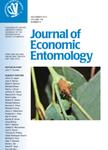版权所有:内蒙古大学图书馆 技术提供:维普资讯• 智图
内蒙古自治区呼和浩特市赛罕区大学西街235号 邮编: 010021

作者机构:Univ Arizona Dept Entomol Tucson AZ 85721 USA Univ Arizona Sch Nat Resources & Environm Arizona Remote Sensing Ctr Tucson AZ 85721 USA Univ Arizona Yuma Co Cooperat Extens Yuma AZ 85364 USA Arizona Cotton Res & Protect Council Phoenix AZ 85040 USA McGill Univ Dept Plant Sci Quebec City PQ H9X 3V9 Canada
出 版 物:《JOURNAL OF ECONOMIC ENTOMOLOGY》 (经济昆虫学杂志)
年 卷 期:2014年第107卷第1期
页 面:1-10页
核心收录:
学科分类:0710[理学-生物学] 07[理学] 09[农学]
基 金:Arizona Department of Agriculture USDA, Agricultural Marketing Service [SCBGP 10-10]
主 题:Bemisia tabaci classification and regression tree cucurbit yellow stunting disorder virus integrated pest management landscape ecology
摘 要:Theory indicates that landscape composition affects transmission of vector-borne crop diseases, but few empirical studies have investigated how landscape composition affects plant disease epidemiology. Since 2006, Bemisia tabaci (Gennadius) has vectored the cucurbit yellow stunting disorder virus (CYSDV) to cantaloupe and honeydew melons (Cucumis melo L.) in the southwestern United States and northern Mexico, causing significant reductions in yield of fall melons and increased use of insecticides. Here, we show that a landscape-based approach allowing simultaneous assessment of impacts of local (i.e., planting date) and regional (i.e., landscape composition) factors provides valuable insights on how to reduce crop disease risks. Specifically, we found that planting fall melon fields early in the growing season, eliminating plants germinating from seeds produced by spring melons after harvest, and planting fall melon fields away from cotton and spring melon fields may significantly reduce the incidence of CYSDV infection in fall melons. Because the largest scale of significance of the positive association between abundance of cotton and spring melon fields and CYSDV incidence was 1,750 and 3,000 m, respectively, reducing areas of cotton and spring melon fields within these distances from fall melon fields may decrease CYSDV incidence. Our results indicate that landscape-based studies will be fruitful to alleviate limitations imposed on crop production by vector-borne diseases.